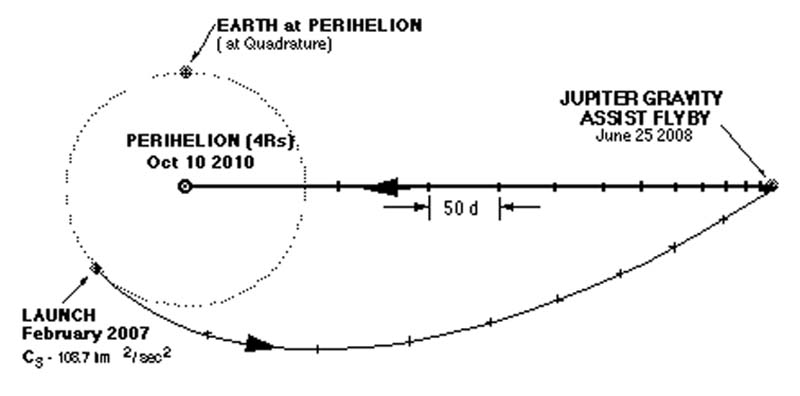| The reason Solar Probe will make two full orbits about the Sun is to
permit observations to be made in the corona near both solar maximum and
solar minimum. This requirement comes from the radically changing nature
of the corona over the 11 year solar sunspot cycle and the “bimodality”
of the solar wind. The solar cycle changes in the corona are shown schematically
in the schematic at the top of this page.
Near solar maximum (panel (a) above), the large scale magnetic field
of the Sun is disordered, coronal mass ejections (CMEs) occur at a rate
of several per day, many solar flares occur each day, and radio, EUV, and
X-ray emissions from the corona are orders of magnitude higher than at
solar minimum. Coronal holes are either absent or very small so that Solar
Probe would have a negligible probability of encountering one. At this
time Solar Probe would collect information on the active Sun and corona,
on the source of the slow wind, on shock waves, and on the acceleration
of energetic particles in the corona.
Near solar minimum (panel (c) above), the Sun’s global magnetic field
is well organized and roughly dipolar. The corona is dominated by large
equatorial streamers, polar coronal holes which extend down to mid-latitudes
at the photosphere and nearly to the equator beyond a few solar radii,
and CMEs occur at a rate of approximately one per day. During this time
Solar Probe would be certain of passing through a polar coronal hole inside
8RS, and probably inside 5RS. Detailed measurements
of the properties of fine structure, waves, and turbulence in the high
speed wind would be made and the properties of quiescent equatorial streamers
could be determined. This is the portion of the mission which would resolve
the many questions about the origin of fast solar wind.
The Solar Probe mission Class A Objectives,
that have been defined from the above unanswered questions and known properties
of the corona are as follows:
-
Determine the acceleration processes
and find the source regions of fast and slow solar wind at maximum and
minimum solar activity.
-
Locate the sources and trace the flow
of energy that heats the corona.
-
Construct the three-dimensional density
configuration from pole to pole, and determine the subsurface flow pattern,
the structure of the polar magentic field and its relationship with the
overlying corona.
-
Identify the acceleration mechanisms
and locate the source regions of energetic particles, and determine the
role of plasma waves and turbulence in the production of solar wind and
energetic particles.
Because of the large solar cycle dependence of the properties of
the corona (see schematic above), it is impossible to meet these Solar
Probe mission objectives in a single pass at any single time in the solar
cycle. Conversely, the mission plan would meet all the objectives through
the use of two passes through the corona at appropriately differing times
in the solar cycle. In the following, details are given on what is known
of the solar corona and why Solar Probe is necessary to address the unanswered
questions.
|

